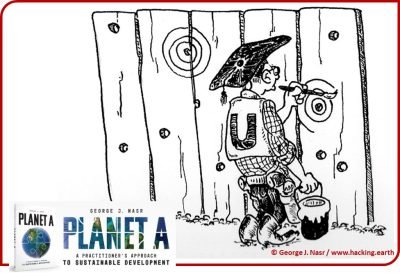Risk, Uncertainty, and Lake Mead
The downfall of Lake Mead is less due to any Climate Emergency, than to the downside of centralization. Lake Mead is part of the current the Colorado River basin; it is a new creation, in a heavily engineered basin. .
It was also typical of centrally-managed projects. In the Colorado River basin, the geographic area drained by the river and its tributaries, the system is optimized to feed the canals and aqueduct in California, which depends so much on the Colorado. With 15 dams along the river and its tributaries, drains an area of 640,000 km2 (a fifth of the United States), across about 2 Mexican states and 7 US states; This is a complex, centralized system, which multiplies risks in the face of a changing climate.
The system worked, until it didn't
The basin was designed at a time when water managers benefit from a measure of "hydraulic certainty", when we could rely on the recent past weather to predict the future weather. It was a centralized system; it is now challenged... as are other complex basins.
On one hand, centralization has its uses. It does allow the center to better acquire, process, and analyze information, than any single individual or locale, as in the case of our increasingly centralized computer ecosystems. On the other hand, centralization is a maladaptation. Centralization freezes evolution and enshrines any bad practice into a “canon” to be respected, or “taboo” to be avoided. When the underlying environment changes, centralization fails us.
We are now in a different era.
We've been entering this era since the late 1990's; since then, the change in the prevailing climate is leading to both greater variability in precipitation, and more frequent extreme weather events are expected to increase in frequency and variability. Precipitation amounts may not change, but the changes will come in two different ways.
Rainfall amounts may not change. However, higher temperatures will have an effect. Less of the precipitation will come as snow, or more of the snow will melt too soon. This means less "reserve" for the warmer months; the melting snow that would otherwise fill-up the dams would have percolated away.
Rainfall variability will increase. Both in space, and in time, in addition to the rate of evaporation. The most significant parameter causing environmental stress is the rainfall pattern, which influences the generation and dependability of freshwater availability in terms of its amount, frequency and distribution.
Because of this, climate change will act as a risk multiplier; it will aggravate any "response measure", and exacerbate water scarcity, and will exacerbate the side-effects of rising complexity and growing centralization. To move forward, we need to revise old engineering assumptions about the climate at the small-scale, and redesign our weather-dependent systems.
The key weather-dependent system is the weather.
Water managers need a wide focus that takes into account the impacts of events in addition to their probability of occurrence. In addition water managers are faced with a domain where “the ‘knowledge base; in this domain is still ‘formative’, as “the knowable remains undetected because of the assumptions that frame the question or methods of analysis”. Until now, attitudes to the new risks created by climate change are evolving very slowly; as recently as 2003, Climate change was still listed among the “Pressures of freshwater ecosystems”, but only under the risk of “Release of pollutants to land, air or water”.
To understand the larger implication of the new risks, we cannot worry too much about uncertainty.
Neither can we rely on forecasts.
We can only use forecasts, and "bound" the uncertainty that we play within...
